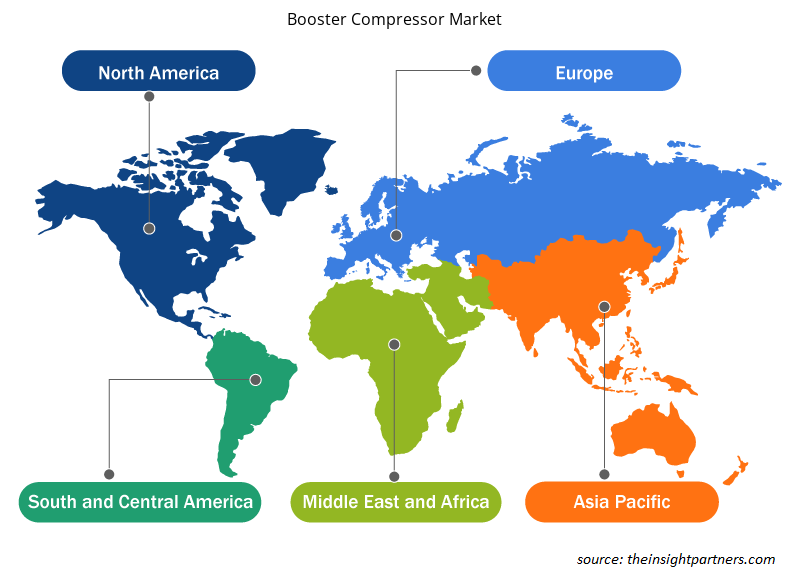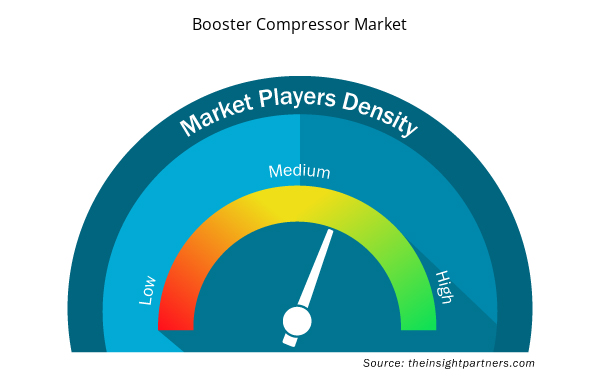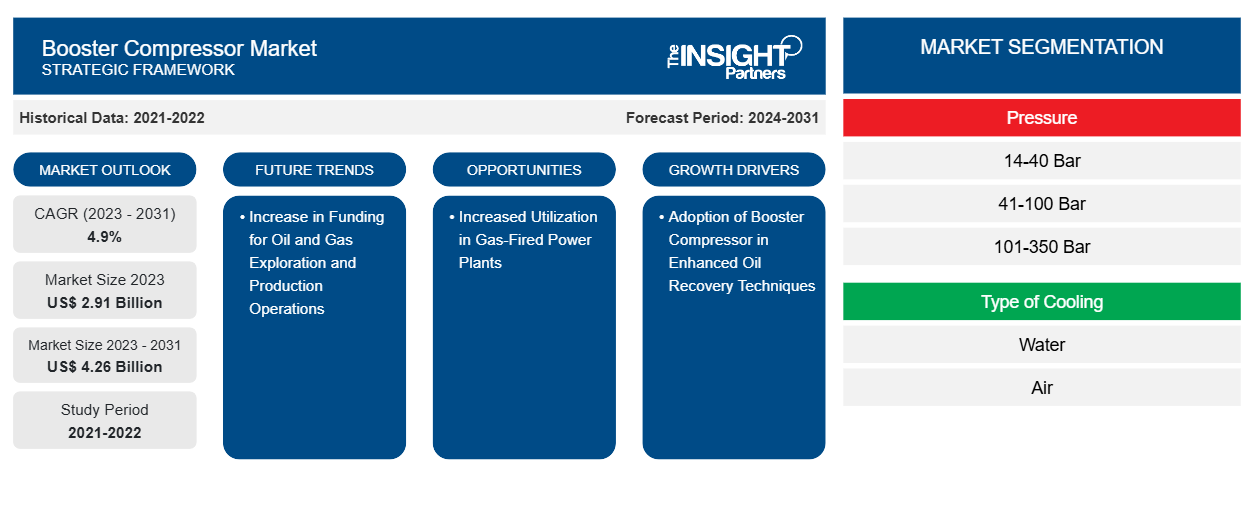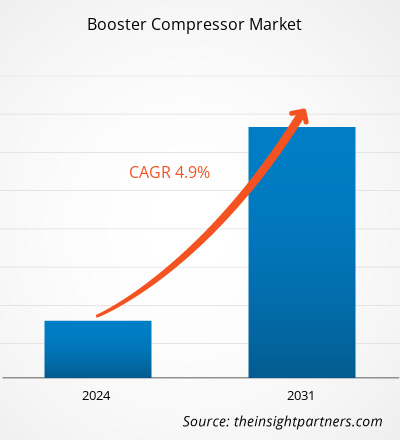Si prevede che la dimensione del mercato dei compressori booster raggiungerà i 4,26 miliardi di dollari entro il 2031, rispetto ai 2,91 miliardi di dollari del 2023. Si prevede che il mercato registrerà un CAGR del 4,9% nel 2023-2031. Un aumento della domanda di booster portatili e un aumento dei finanziamenti per le operazioni di esplorazione e produzione di petrolio e gas rimarranno probabilmente una tendenza chiave del mercato dei compressori booster.
Analisi di mercato dei compressori booster
Si prevede che il mercato dei compressori booster crescerà rapidamente nel prossimo futuro a causa dell'espansione dei progetti industriali a livello globale e della crescente domanda di gas naturale per vari scopi. Si prevede che questa crescita porterà a un aumento dei progetti di gasdotti. Il sostanziale progresso dei settori di utilizzo finale, tra cui petrolio e gas, estrazione mineraria, produzione, edilizia, automotive e altri, sta spingendo l'espansione del settore dei compressori booster. Inoltre, la crescente necessità di compressori booster nei test industriali sta contribuendo alla crescita globale del mercato.
Panoramica del mercato dei compressori booster
Un compressore booster è un dispositivo specializzato creato per aumentare la pressione del sistema, in genere da quattro a sei volte superiore alla pressione prodotta dalle apparecchiature standard di fabbrica. A causa delle potenziali difficoltà e dei costi associati al mantenimento di tali livelli di pressione elevati, la maggior parte delle aziende utilizza un compressore booster su base temporanea. Sebbene possa essere utilizzato per il funzionamento delle apparecchiature, è più comunemente impiegato per scopi di collaudo. Mentre la maggior parte di questi compressori sono pneumatici o ad aria compressa, alcuni utilizzano anche fonti di energia alternative.
Personalizza questo report in base alle tue esigenze
Riceverai la personalizzazione gratuita di qualsiasi report, comprese parti di questo report, o analisi a livello nazionale, pacchetto dati Excel, oltre a usufruire di grandi offerte e sconti per start-up e università
- Scopri le principali tendenze di mercato in questo rapporto.Questo campione GRATUITO includerà analisi di dati che spaziano dalle tendenze di mercato alle stime e alle previsioni.
Driver e opportunità del mercato dei compressori booster
Adozione del compressore booster nelle tecniche di recupero avanzato dell'olio per favorire il mercato
L'industria del gas naturale si è sempre più concentrata sullo sviluppo di riserve di gas non convenzionali tecnologicamente più impegnative, come scisto, sabbie compatte e metano da giacimenti carboniferi. Ciò ha portato all'utilizzo di gas pressurizzato durante le fasi di recupero avanzato del petrolio (EOR) e recupero secondario della produzione di greggio per aumentare la pressione all'interno della formazione e stimolare la produttività del pozzo. Di conseguenza, vengono utilizzati compressori che vanno da 1040 a 3900 cavalli di potenza per questo scopo, guidando così la domanda nel settore del petrolio e del gas.coalbed methane. This has led to the utilization of pressurized gas during the enhanced oil recovery (EOR) and secondary recovery phases of crude production to increase the pressure within the formation and stimulate well productivity. As a result, compressors ranging from 1040 to 3900 horsepower are being used for this purpose, thereby driving the demand in the
Aumento dell’utilizzo nelle centrali elettriche a gas: un’opportunità per il mercato
La domanda di compressori booster è in aumento a causa della transizione dalle centrali elettriche a carbone a quelle a gas naturale per la produzione di elettricità. La Germania, ad esempio, ha approvato una legge per porre fine alla produzione di energia a carbone entro il 2038 e molti paesi in tutto il mondo stanno investendo in progetti di centrali elettriche a gas naturale. Le turbine a gas in queste centrali elettriche richiedono una pressione specifica del gas combustibile per combinarsi con l'aria pressurizzata prima della combustione. Di conseguenza, la domanda di compressori è in crescita, poiché le turbine a gas richiedono pressioni del gas combustibile più elevate per ottenere una migliore efficienza delle prestazioni. Inoltre, le pressioni delle condotte fluttuano a causa dell'aumento della domanda di picco e dei requisiti generali. Questo passaggio verso fonti energetiche a basse emissioni di carbonio a livello globale sta guidando la domanda di mercato per i booster durante il periodo di previsione.
Analisi della segmentazione del rapporto di mercato del compressore booster
I segmenti chiave che hanno contribuito alla derivazione dell'analisi di mercato dei compressori booster sono la pressione, il tipo di raffreddamento, lo stadio di compressione e il settore verticale.
- In base alla pressione, il mercato è segmentato in 14-40 Bar,41-100 Bar, 101-350 Bar e >350 Bar. Il segmento 41-100 Bar ha detenuto una quota di mercato sostanziale nel 2023.
- In base al tipo di raffreddamento, il mercato è diviso in acqua e aria. Si prevede che il segmento dell'acqua deterrà una quota significativa del mercato nel 2023.
- In base alla fase di compressione, il mercato è suddiviso in singolo, doppio e multiplo. Si prevede che il segmento singolo deterrà una quota significativa del mercato nel 2023.
- In base al settore verticale, il mercato è segmentato in produzione, prodotti chimici, petrolio e gas, energia ed energia elettrica e altri. Il segmento manifatturiero ha detenuto una quota di mercato sostanziale nel 2023.
Analisi della quota di mercato dei compressori booster per area geografica
L'ambito geografico del rapporto sul mercato dei compressori booster è suddiviso principalmente in cinque regioni: Nord America, Asia Pacifico, Europa, Medio Oriente e Africa e Sud America/Sud e Centro America.
Si prevede che l'Europa sperimenterà una crescita sostanziale della domanda di energia, guidata dal maggiore utilizzo di gas industriali ad alta pressione in settori quali acciaio, petrolio e gas, metalli e miniere e produzione e lavorazione. Si prevede che questo aumento della domanda per il mercato in tutta Europa porterà a una crescita annuale dell'1,5% della domanda di gas naturale dal 2019 al 2025, come indicato dall'Agenzia Internazionale per l'Energia (IEA). Nel 2019, l'Europa ha importato un volume significativo di GNL, pari a 108 miliardi di metri cubi (bcm), che hanno rappresentato il 27% delle importazioni totali di gas, secondo il rapporto della Commissione Europea (CE) sul mercato del gas. Inoltre, il 22% del consumo di gas in Europa è attribuito al mercato spot e non comporta spese in conto capitale da parte di piccoli operatori, il che ha ulteriormente stimolato la domanda per il mercato nella regione.
Approfondimenti regionali sul mercato dei compressori booster
Le tendenze regionali e i fattori che influenzano il mercato dei compressori booster durante il periodo di previsione sono stati ampiamente spiegati dagli analisti di Insight Partners. Questa sezione discute anche i segmenti e la geografia del mercato dei compressori booster in Nord America, Europa, Asia Pacifico, Medio Oriente e Africa e America meridionale e centrale.

- Ottieni i dati specifici regionali per il mercato dei compressori booster
Ambito del rapporto di mercato del compressore booster
| Attributo del report | Dettagli |
|---|---|
| Dimensioni del mercato nel 2023 | 2,91 miliardi di dollari USA |
| Dimensioni del mercato entro il 2031 | 4,26 miliardi di dollari USA |
| CAGR globale (2023-2031) | 4,9% |
| Dati storici | 2021-2022 |
| Periodo di previsione | 2024-2031 |
| Segmenti coperti | Per pressione
|
| Regioni e Paesi coperti | America del Nord
|
| Leader di mercato e profili aziendali chiave |
|
Densità dei player del mercato dei compressori booster: comprendere il suo impatto sulle dinamiche aziendali
Il mercato dei compressori booster sta crescendo rapidamente, spinto dalla crescente domanda degli utenti finali dovuta a fattori quali l'evoluzione delle preferenze dei consumatori, i progressi tecnologici e una maggiore consapevolezza dei vantaggi del prodotto. Con l'aumento della domanda, le aziende stanno ampliando le loro offerte, innovando per soddisfare le esigenze dei consumatori e capitalizzando sulle tendenze emergenti, il che alimenta ulteriormente la crescita del mercato.
La densità degli operatori di mercato si riferisce alla distribuzione di aziende o società che operano in un particolare mercato o settore. Indica quanti concorrenti (operatori di mercato) sono presenti in un dato spazio di mercato in relazione alle sue dimensioni o al valore di mercato totale.
Le principali aziende che operano nel mercato dei compressori booster sono:
- Atlas Copco Italia
- Baker Huges (Elettricità generale)
- Società a responsabilità limitata BAUER COMP Holding GmbH
- Boge Compressori
- Corken, Inc.
- Gardner Denver, Inc.
Disclaimer : le aziende elencate sopra non sono classificate secondo un ordine particolare.

- Ottieni una panoramica dei principali attori del mercato dei compressori booster
Notizie di mercato e sviluppi recenti sui compressori booster
Il mercato dei compressori booster viene valutato raccogliendo dati qualitativi e quantitativi dopo la ricerca primaria e secondaria, che include importanti pubblicazioni aziendali, dati associativi e database. Di seguito è riportato un elenco degli sviluppi nel mercato:
- La tecnologia di Hycomp Inc. è diventata parte di Atlas Copco Group. L'azienda progetta, produce, vende e fornisce assistenza per compressori e booster oil-free ad alta pressione specializzati per una varietà di settori.
(Fonte: Atlas Copco AB, Comunicati stampa, 2024)
Copertura e risultati del rapporto sul mercato dei compressori booster
Il rapporto "Dimensioni e previsioni del mercato dei compressori booster (2021-2031)" fornisce un'analisi dettagliata del mercato che copre le seguenti aree:
- Dimensioni e previsioni del mercato a livello globale, regionale e nazionale per tutti i segmenti di mercato chiave coperti dall'ambito
- Dinamiche di mercato come fattori trainanti, vincoli e opportunità chiave
- Principali tendenze future
- Analisi dettagliata delle cinque forze PEST/Porter e SWOT
- Analisi di mercato globale e regionale che copre le principali tendenze di mercato, i principali attori, le normative e gli sviluppi recenti del mercato
- Analisi del panorama industriale e della concorrenza che copre la concentrazione del mercato, l'analisi della mappa di calore, i principali attori e gli sviluppi recenti
- Profili aziendali dettagliati
- Analisi storica (2 anni), anno base, previsione (7 anni) con CAGR
- Analisi PEST e SWOT
- Valore/volume delle dimensioni del mercato - Globale, regionale, nazionale
- Industria e panorama competitivo
- Set di dati Excel



Report Coverage
Revenue forecast, Company Analysis, Industry landscape, Growth factors, and Trends

Segment Covered
This text is related
to segments covered.

Regional Scope
North America, Europe, Asia Pacific, Middle East & Africa, South & Central America

Country Scope
This text is related
to country scope.
Domande frequenti
The market is expected to reach US$ 4.26 billion by 2031.
The key players holding significant shares in the market are Atlas Copco AB, Baker Huges (General Electric), BAUER COMP Holding GmbH, Boge Kompressoren, and Corken, Inc.
Increase in funding for oil and gas exploration and production operations is anticipated to play a significant role in the market in the coming years.
The adoption of booster compressors in enhanced oil recovery techniques and the rise in the demand for portable boosters are the major factors that propel the market.
The market was estimated to be US$ 2.91 billion in 2023 and is expected to grow at a CAGR of 4.9% during the period 2023 - 2031.
Trends and growth analysis reports related to Electronics and Semiconductor : READ MORE..
The Insight Partners performs research in 4 major stages: Data Collection & Secondary Research, Primary Research, Data Analysis and Data Triangulation & Final Review.
- Data Collection and Secondary Research:
As a market research and consulting firm operating from a decade, we have published and advised several client across the globe. First step for any study will start with an assessment of currently available data and insights from existing reports. Further, historical and current market information is collected from Investor Presentations, Annual Reports, SEC Filings, etc., and other information related to company’s performance and market positioning are gathered from Paid Databases (Factiva, Hoovers, and Reuters) and various other publications available in public domain.
Several associations trade associates, technical forums, institutes, societies and organization are accessed to gain technical as well as market related insights through their publications such as research papers, blogs and press releases related to the studies are referred to get cues about the market. Further, white papers, journals, magazines, and other news articles published in last 3 years are scrutinized and analyzed to understand the current market trends.
- Primary Research:
The primarily interview analysis comprise of data obtained from industry participants interview and answers to survey questions gathered by in-house primary team.
For primary research, interviews are conducted with industry experts/CEOs/Marketing Managers/VPs/Subject Matter Experts from both demand and supply side to get a 360-degree view of the market. The primary team conducts several interviews based on the complexity of the markets to understand the various market trends and dynamics which makes research more credible and precise.
A typical research interview fulfils the following functions:
- Provides first-hand information on the market size, market trends, growth trends, competitive landscape, and outlook
- Validates and strengthens in-house secondary research findings
- Develops the analysis team’s expertise and market understanding
Primary research involves email interactions and telephone interviews for each market, category, segment, and sub-segment across geographies. The participants who typically take part in such a process include, but are not limited to:
- Industry participants: VPs, business development managers, market intelligence managers and national sales managers
- Outside experts: Valuation experts, research analysts and key opinion leaders specializing in the electronics and semiconductor industry.
Below is the breakup of our primary respondents by company, designation, and region:

Once we receive the confirmation from primary research sources or primary respondents, we finalize the base year market estimation and forecast the data as per the macroeconomic and microeconomic factors assessed during data collection.
- Data Analysis:
Once data is validated through both secondary as well as primary respondents, we finalize the market estimations by hypothesis formulation and factor analysis at regional and country level.
- Macro-Economic Factor Analysis:
We analyse macroeconomic indicators such the gross domestic product (GDP), increase in the demand for goods and services across industries, technological advancement, regional economic growth, governmental policies, the influence of COVID-19, PEST analysis, and other aspects. This analysis aids in setting benchmarks for various nations/regions and approximating market splits. Additionally, the general trend of the aforementioned components aid in determining the market's development possibilities.
- Country Level Data:
Various factors that are especially aligned to the country are taken into account to determine the market size for a certain area and country, including the presence of vendors, such as headquarters and offices, the country's GDP, demand patterns, and industry growth. To comprehend the market dynamics for the nation, a number of growth variables, inhibitors, application areas, and current market trends are researched. The aforementioned elements aid in determining the country's overall market's growth potential.
- Company Profile:
The “Table of Contents” is formulated by listing and analyzing more than 25 - 30 companies operating in the market ecosystem across geographies. However, we profile only 10 companies as a standard practice in our syndicate reports. These 10 companies comprise leading, emerging, and regional players. Nonetheless, our analysis is not restricted to the 10 listed companies, we also analyze other companies present in the market to develop a holistic view and understand the prevailing trends. The “Company Profiles” section in the report covers key facts, business description, products & services, financial information, SWOT analysis, and key developments. The financial information presented is extracted from the annual reports and official documents of the publicly listed companies. Upon collecting the information for the sections of respective companies, we verify them via various primary sources and then compile the data in respective company profiles. The company level information helps us in deriving the base number as well as in forecasting the market size.
- Developing Base Number:
Aggregation of sales statistics (2020-2022) and macro-economic factor, and other secondary and primary research insights are utilized to arrive at base number and related market shares for 2022. The data gaps are identified in this step and relevant market data is analyzed, collected from paid primary interviews or databases. On finalizing the base year market size, forecasts are developed on the basis of macro-economic, industry and market growth factors and company level analysis.
- Data Triangulation and Final Review:
The market findings and base year market size calculations are validated from supply as well as demand side. Demand side validations are based on macro-economic factor analysis and benchmarks for respective regions and countries. In case of supply side validations, revenues of major companies are estimated (in case not available) based on industry benchmark, approximate number of employees, product portfolio, and primary interviews revenues are gathered. Further revenue from target product/service segment is assessed to avoid overshooting of market statistics. In case of heavy deviations between supply and demand side values, all thes steps are repeated to achieve synchronization.
We follow an iterative model, wherein we share our research findings with Subject Matter Experts (SME’s) and Key Opinion Leaders (KOLs) until consensus view of the market is not formulated – this model negates any drastic deviation in the opinions of experts. Only validated and universally acceptable research findings are quoted in our reports.
We have important check points that we use to validate our research findings – which we call – data triangulation, where we validate the information, we generate from secondary sources with primary interviews and then we re-validate with our internal data bases and Subject matter experts. This comprehensive model enables us to deliver high quality, reliable data in shortest possible time.


 Ottieni un campione gratuito per questo repot
Ottieni un campione gratuito per questo repot